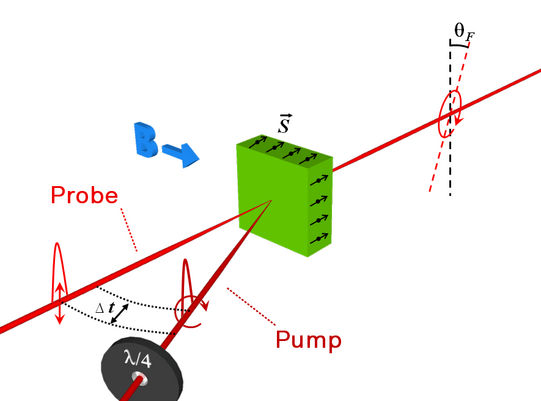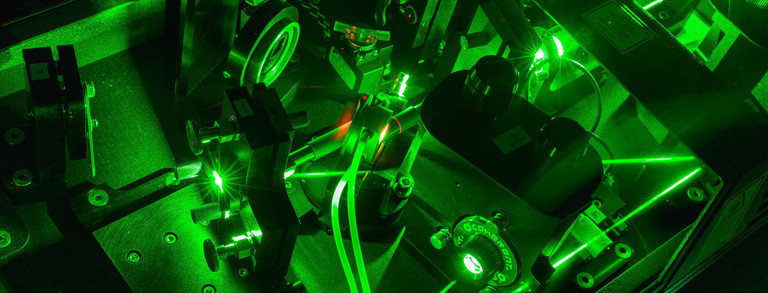Coherent Spin Dynamics
Quantum effects such as superposition and entanglement may ultimately be used as computational resources in future quantum computers. The spin degree of freedom of charge carriers in semiconductor nanostructures is a promising candidate for implementing a qubit, the unit of quantum information.
Significant challenges in this area include the detection of spin coherence in nanoscale structures, the optimization of electron or hole spin lifetimes, and the coherent manipulation of the spin states on sufficiently short time scales. Experiments suggest that the storage time of quantum information encoded in electron spins may be extended through their strong interplay with nuclear spins.
A very suitable technique to investigate coherent spin dynamics in semiconductor nanostructures is the pump-probe spectroscopy. In its simplest form, the output pulse train from an ultrafast laser (pulse durations of 150 fs to 80 ps at a repetition rate of 76 MHz) is divided into two. The semiconductor sample under investigation is excited by one pulse train (pump) and the changes it induces in the sample are probed by the second pulse train (probe), which is suitably delayed with respect to the pump by introducing an optical delay in either the pump or the probe path. Some property related to the probe (e.g. polarization, reflectivity, absorption, luminescence) is then monitored to investigate the changes in the sample produced by the pump. The measurements of the optical polarization of the probe pulse transmitted through (or reflected from) the semiconductor are used to monitor the time evolution of the spin polarization induced by the circularly polarized pump pulse. This kind of pump-probe spectroscopy is usually called the time-resolved Faraday (or Kerr) rotation, because the angle of the probe's linear polarization is rotated depending of the magnetization resulting from the aligned spins ("Faraday effect").
It is also possible to use several synchronized pulse lasers to do experiments with more than one pump beam, control beams or a probe beam of different energy.

Main Results:
Mode-locking of electron spin coherence
It was shown that the precession frequencies of an ensemble of electron spins in InAs/GaAs quantum dots (QDs) can be focused into well-defined modes synchronized with a laser pulse protocol. Thus the problem of dephasing on a nanosecond timescale due to inhomogeneous broadening of QD properties can be overcome and electron spin coherence times of microseconds are measurable. [A. Greilich et al., Science 313 (2006)]
Ultrafast optical spin rotation
With a third "control" beam of specific energy and pulse area it is possible to rotate the electron spin confined in a QD by an arbitrary angle about the optical axis. Together with the precession about the magnetic field axis, which is perpendicular to the optical one, the spin can be rotated in any desired direction withthin picoseconds. [A. Greilich et al., Nature Phys. 5 (2009)]
Optical control of coherent interactions between electron spins
In an ensemble of quantum dots several spin subsets representing qubits can be addressed by pump beams of different transition energy. Measurements demonstrate phase shifts and modulations of the magnitude of spin precession in one subset of oriented spins after optical orientation of a second subset. The observations are consistent with results from a model using a Heisenberg-like interaction with µeV interaction strength. [S. Spatzek et al., Phys. Rev. Lett. 107 (2011)]
Current offers for Bachelor-, Master- or PhD-theses
We offer Bachelor-, Master- and PhD-theses in relation to the ongoing research on coherent spin dynamics in semiconductor quantum dots or quantum wells. Feel free to ask someone of the team for more information!
Contact
- Prof. Dr. Evgeny Zhukov
- PD Dr. Alex Greilich
- Erik Kirstein
- Eiko Evers
- Vitalie Nedelea
- David Kowski
Collaborations
- Angewandte Festkörperphysik, Ruhr-Universität Bochum
- Spin Optics Laboratory, St. Petersburg State University
- Ioffe Physical-Technical Institute, Russian Acadamy of Sciences
- Physics of Semiconductors, Moscow State University
- Theory of Nanostructures, U.S. Naval Research Laboratory
- Instituto de Física, Universidade de São Paulo



